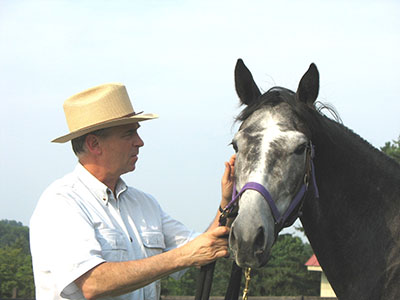Doug Antczak, VMD, PhD

Baker Institute for Animal Health
Department of Microbiology and Immunology
Dorothy Havemeyer McConville Professor of Equine Medicine
Professor
Baker Institute for Animal Health
Office: 607.256.5633
Fax: 607.256.5608
Email: dfa1@cornell.edu
Dr. Antczak's Work
Doug Antczak’s research program is focused on the health of horses, a passion of his from an early age. Through the Baker Institute’s Equine Genetics Center, the Antczak laboratory group has a long history of advancing basic knowledge and applying that knowledge in equine genetics, immunology, and reproduction. The cord that links these three distinct areas of science together is the intimate relationship between mother and fetus during pregnancy in mammals. A developing fetus is, in a way, like a tissue graft, a foreign piece of material transplanted from another animal. In most cases, the mother’s immune system tolerates this “graft” very well and pregnancy and birth end in a happy result because the placenta provides a protective barrier around the developing embryo and forms the interface with the mother’s uterus. For over 30 years, Dr. Antczak has investigated how the placenta and fetus avoid recognition and destruction by the mother’s immune system. The horse has been a particularly useful species in which to study this question because of several unique features of the equine placenta.
The fetus is able to survive, in part, thanks to genes of the Major Histocompatibility Complex (MHC) on the surface of the placenta. These MHC genes encode molecules that are normally targeted by the immune responses that cause graft rejection. By switching off the MHC genes in the placenta, the fetus becomes largely invisible to the mother’s immune system. Studies of this evasion-by-stealth mechanism are relevant to reproductive health not only in horses, but in all animals, including humans, and discoveries in this area could lead to improved methods of organ transplantation, advances in cancer biology, and progress against infectious disease.
To support the Institute’s studies of pregnancy immunology in the horse, Dr. Antczak has developed a unique herd of horses selected for homozygosity at the MHC, meaning they all share the same forms of this important set of immune system genes. Because the horses in these homozygous lines carry identical MHC genes, they can be used for a wide variety of investigations that require detailed knowledge of these cardinal genes of the immune system. Dr. Antczak’s genetic selection and breeding of horses led to his continuing involvement in the international Horse Genome Project. Horses from the Institute’s experimental herd include the Thoroughbred stallion Bravo, the DNA donor for the equine Bacterial Artificial Chromosome library, and Twilight, the Thoroughbred mare whose DNA was the source for the horse genome sequence.
In another project involving the MHC, Dr. Antczak is working equine herpesvirus type 1 (EHV-1), a highly infectious pathogen that causes respiratory infections, abortions, and severe neurologic disease. Together with Dr. Klaus Osterrieder of the Free University of Berlin and Dr. Becky Tallmadge of the Department of Clinical Sciences at Cornell, Dr. Antczak is trying to determine how the virus interacts with one type of MHC molecules to gain entry to horse cells. Using advanced techniques in cell and molecular biology, Dr. Antczak’s team has been able to identify which MHC molecules enable the virus to enter the cell and to discern how efficient they are compared with other receptors that allow the virus to enter. These distinctions, which are genetically based, can help determine why some animals, and some humans, are more susceptible to herpesvirus infection than others, and can point the way to preventive therapies to keep herpesvirus from grasping these receptors, entering the cell, and making an animal or human sick.
Papillomaviruses present another example of viral pathogens where genetic susceptibility plays a role in infection. Bovine papillomavirus is a pathogen of cattle that has crossed over to horses where it can cause sarcoid tumors, wart-like lesions that are the most common type of cancer in the horse. With Dr. Samantha Brooks of the University of Florida, Dr. Antczak used whole genome scanning to identify two regions in the horse genome that are associated with sarcoid tumors. One of these regions is within the MHC. Dr. Antczak is currently working to identify the locations of the genes involved in sarcoid susceptibility and elucidating the mechanisms that lead to the formation of tumors, discoveries that could lead to therapies for sarcoid tumors and other diseases caused by papillomaviruses.
Horses are still beasts of burden in most parts of the world, but on the other side of the planet, in Qatar, camels also step in to carry people and heavy loads. The Dromedary camel, together with the Arabian horse and the Arabian oryx, represent three iconic mammals of the Arabian Peninsula, and with support from the Qatar National Research Foundation, Dr. Antczak’s lab is sequencing and exploring the genomes of these three species. By gauging the diversity of these genomes within species and identifying commonalities between different species, Dr. Antczak hopes to identify genomic regions that contain novel pathways for survival in an arid environment and gain insights into how these species might survive in a future in which climate change further diminishes water resources on the Arabian Peninsula.



